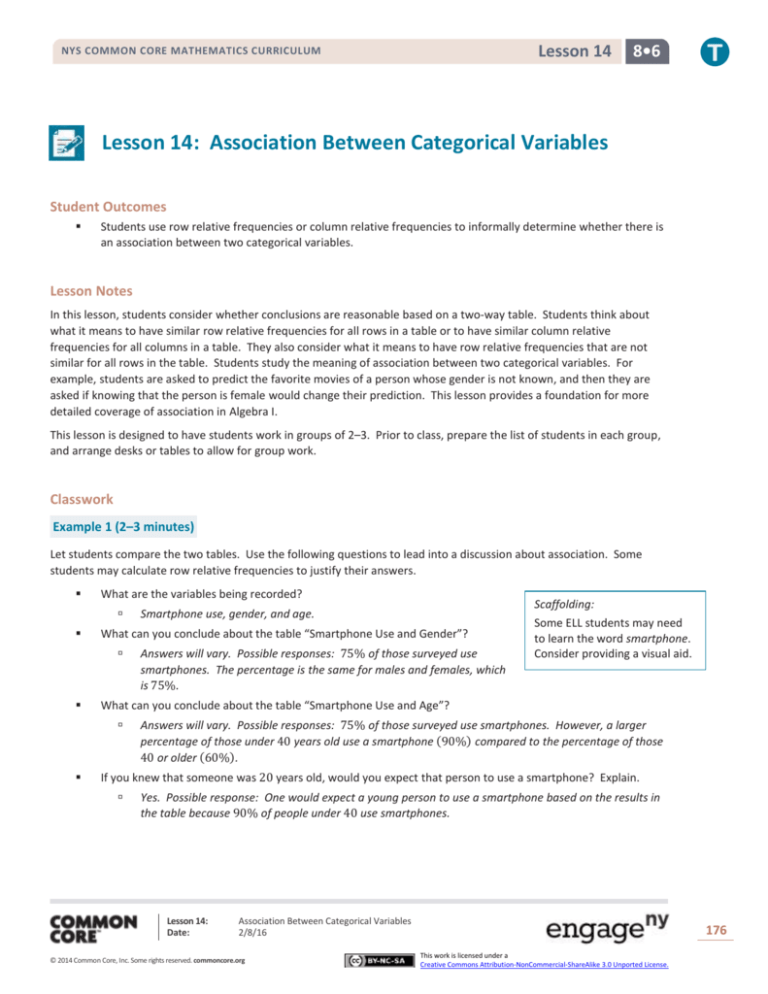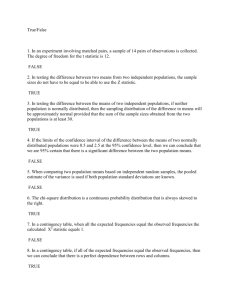
Lesson 14
NYS COMMON CORE MATHEMATICS CURRICULUM
8•6
Lesson 14: Association Between Categorical Variables
Student Outcomes
Students use row relative frequencies or column relative frequencies to informally determine whether there is
an association between two categorical variables.
Lesson Notes
In this lesson, students consider whether conclusions are reasonable based on a two-way table. Students think about
what it means to have similar row relative frequencies for all rows in a table or to have similar column relative
frequencies for all columns in a table. They also consider what it means to have row relative frequencies that are not
similar for all rows in the table. Students study the meaning of association between two categorical variables. For
example, students are asked to predict the favorite movies of a person whose gender is not known, and then they are
asked if knowing that the person is female would change their prediction. This lesson provides a foundation for more
detailed coverage of association in Algebra I.
This lesson is designed to have students work in groups of 2–3. Prior to class, prepare the list of students in each group,
and arrange desks or tables to allow for group work.
Classwork
Example 1 (2–3 minutes)
Let students compare the two tables. Use the following questions to lead into a discussion about association. Some
students may calculate row relative frequencies to justify their answers.
What are the variables being recorded?
What can you conclude about the table “Smartphone Use and Gender”?
Answers will vary. Possible responses: 75% of those surveyed use
smartphones. The percentage is the same for males and females, which
is 75%.
Some ELL students may need
to learn the word smartphone.
Consider providing a visual aid.
What can you conclude about the table “Smartphone Use and Age”?
Scaffolding:
Smartphone use, gender, and age.
Answers will vary. Possible responses: 75% of those surveyed use smartphones. However, a larger
percentage of those under 40 years old use a smartphone (90%) compared to the percentage of those
40 or older (60%).
If you knew that someone was 20 years old, would you expect that person to use a smartphone? Explain.
Yes. Possible response: One would expect a young person to use a smartphone based on the results in
the table because 90% of people under 40 use smartphones.
Lesson 14:
Date:
Association Between Categorical Variables
2/8/16
© 2014 Common Core, Inc. Some rights reserved. commoncore.org
176
This work is licensed under a
Creative Commons Attribution-NonCommercial-ShareAlike 3.0 Unported License.
Lesson 14
NYS COMMON CORE MATHEMATICS CURRICULUM
8•6
Example 1
Suppose a random group of people are surveyed about their use of smartphones. The results of the survey are
summarized in the tables below.
Smartphone Use and Gender
Smartphone Use and Age
Use
Smartphone
Do not Use
Smartphone
Total
Male
𝟑𝟎
𝟏𝟎
𝟒𝟎
Female
𝟒𝟓
𝟏𝟓
𝟔𝟎
Total
𝟕𝟓
𝟐𝟓
𝟏𝟎𝟎
Use
Smartphone
Do not Use
Smartphone
Total
𝟒𝟓
𝟓
𝟓𝟎
𝟑𝟎
𝟐𝟎
𝟓𝟎
𝟕𝟓
𝟐𝟓
𝟏𝟎𝟎
Under 𝟒𝟎
Years of Age
𝟒𝟎 Years of
Age or Older
Total
Example 2 (2 minutes)
Read the beginning of Example 2 to the class. Ask students:
What are the variables being recorded?
Movie preference and teacher or student status.
Example 2
Suppose a sample of 𝟒𝟎𝟎 participants (teachers and students) was randomly selected from the middle schools and high
schools in a large city. These participants responded to the question:
Which type of movie do you prefer to watch?
1.
Action (The Avengers, Man of Steel, etc.)
2.
Drama (42 (The Jackie Robinson Story), The Great Gatsby, etc.)
3.
Science-Fiction (Star Trek into Darkness, World War Z, etc.)
4.
Comedy (Monsters University, Despicable Me 2, etc.)
Movie preference and status (teacher/student) were recorded for each participant.
Exercises 1–7 (12–15 minutes)
Have students work in small groups. Give groups 1–2 minutes to answer Exercise 1, and then confirm their answers as a
class.
Students should read the results of the survey. Remind them that a row relative frequency is the cell frequency divided
by the corresponding row total. Allow groups to answer Exercises 2–5, and then confirm answers as a class. Give groups
adequate time to discuss Exercises 6 and 7, and then discuss as a class.
Lesson 14:
Date:
Association Between Categorical Variables
2/8/16
© 2014 Common Core, Inc. Some rights reserved. commoncore.org
177
This work is licensed under a
Creative Commons Attribution-NonCommercial-ShareAlike 3.0 Unported License.
Lesson 14
NYS COMMON CORE MATHEMATICS CURRICULUM
8•6
Exercises 1–7
1.
Two variables were recorded. Are these variables categorical or numerical?
Both variables are categorical.
2.
The results of the survey are summarized in the table below.
Movie Preference
a.
Action
Drama
Science-Fiction
Comedy
Total
Student
Teacher
𝟏𝟐𝟎
𝟔𝟎
𝟑𝟎
𝟗𝟎
𝟑𝟎𝟎
𝟒𝟎
𝟐𝟎
𝟏𝟎
𝟑𝟎
𝟏𝟎𝟎
Total
𝟏𝟔𝟎
𝟖𝟎
𝟒𝟎
𝟏𝟐𝟎
𝟒𝟎𝟎
What proportion of participants who are teachers would prefer action movies?
𝟒𝟎
= 𝟎. 𝟒𝟎
𝟏𝟎𝟎
b.
What proportion of participants who are teachers would prefer drama movies?
𝟐𝟎
= 𝟎. 𝟐𝟎
𝟏𝟎𝟎
c.
What proportion of participants who are teachers would prefer science-fiction movies?
𝟏𝟎
= 𝟎. 𝟏𝟎
𝟏𝟎𝟎
d.
What proportion of participants who are teachers would prefer comedy movies?
𝟑𝟎
= 𝟎. 𝟑𝟎
𝟏𝟎𝟎
The answers to Exercise 2 are called row relative frequencies. Notice that you divided each cell frequency in the teacher
row by the row total for that row. Below is a blank relative frequency table.
Table of Row Relative Frequencies
Movie Preference
Action
Drama
Science-Fiction
Comedy
Student
𝟎. 𝟒𝟎
𝟎. 𝟐𝟎
𝟎. 𝟏𝟎
𝟎. 𝟑𝟎
Teacher
(a) 𝟎. 𝟒𝟎
(b) 𝟎. 𝟐𝟎
(c) 𝟎. 𝟏𝟎
(d) 𝟎. 𝟑𝟎
Write your answers from Exercise 2 in the indicated cells in the table above.
3.
Find the row relative frequencies for the student row. Write your answers in the table above.
a.
What proportion of participants who are students prefers action movies?
b.
What proportion of participants who are students prefers drama movies?
c.
What proportion of participants who are students prefers science-fiction movies?
d.
What proportion of participants who are students prefers comedy movies?
See table above.
Lesson 14:
Date:
Association Between Categorical Variables
2/8/16
© 2014 Common Core, Inc. Some rights reserved. commoncore.org
178
This work is licensed under a
Creative Commons Attribution-NonCommercial-ShareAlike 3.0 Unported License.
Lesson 14
NYS COMMON CORE MATHEMATICS CURRICULUM
4.
8•6
Is a participant’s status (i.e., teacher or student) related to what type of movie he or she would prefer to watch?
Why or why not? Discuss this with your group.
No, because teachers are just as likely to prefer each movie type as students are, according to the row relative
frequencies.
5.
What does it mean when we say that there is no association between two variables? Discuss this with your group.
Answers will vary. No association means that knowing the value of one variable does not tell you anything about
the value of the other variable.
6.
Scaffolding:
Notice that the row relative frequencies for each movie type are the same for both the
teacher and student rows. When this happens we say that the two variables, movie
preference and status (student/teacher), are NOT associated. Another way of thinking
about this is to say that knowing if a participant is a teacher (or a student) provides no
information about his or her movie preference.
For ELL students, the concept
of no association may be
difficult. Although, for
students working in groups,
consider explicitly modeling
the thinking employed in
Exercise 6.
What does it mean if row relative frequencies are not the same for all rows of a two-way
table?
It means that there is an association or tendency between the two variables.
7.
You can also evaluate whether two variables are associated by looking at column relative frequencies instead of row
relative frequencies. A column relative frequency is a cell frequency divided by the corresponding column total. For
example, the column relative frequency for the Student-Action cell is
a.
𝟏𝟐𝟎
𝟏𝟔𝟎
= 𝟎. 𝟕𝟓.
Calculate the other column relative frequencies and write them in the table below.
Table of Column Relative Frequencies
Movie Preference
b.
Action
Drama
Science-Fiction
Comedy
Student
𝟎. 𝟕𝟓
𝟎. 𝟕𝟓
𝟎. 𝟕𝟓
𝟎. 𝟕𝟓
Teacher
𝟎. 𝟐𝟓
𝟎. 𝟐𝟓
𝟎. 𝟐𝟓
𝟎. 𝟐𝟓
What do you notice about the column relative frequencies for the four columns?
The column relative frequencies are equal for all four columns.
c.
What would you conclude about association based on the column relative frequencies?
Because the column relative frequencies are the same for all four columns, we would conclude that there is no
association between movie preference and status.
In this part of the lesson, students should understand that there is a mathematical way to determine if there is no
association between two categorical variables. Students can look to see if the row relative frequencies are the same (or
approximately the same) for each row in the table. Discuss the mathematical method for determining if there is no
association between two categorical variables.
Lesson 14:
Date:
Association Between Categorical Variables
2/8/16
© 2014 Common Core, Inc. Some rights reserved. commoncore.org
179
This work is licensed under a
Creative Commons Attribution-NonCommercial-ShareAlike 3.0 Unported License.
Lesson 14
NYS COMMON CORE MATHEMATICS CURRICULUM
8•6
Example 3 (2 minutes)
Introduce the data in Example 3. Give students a moment to read the results. Take a quick movie-preference poll in
class. Ask the following:
Who likes action movies?
Do you think movie preference is equal among males and females?
Answers will vary. Encourage students to explain why they think the preferences might be equal or
different.
Example 3
In the survey described in Example 2, gender for each of the 𝟒𝟎𝟎 participants was also recorded. Some results of the
survey are given below:
𝟏𝟔𝟎 participants preferred action movies.
𝟖𝟎 participants preferred drama movies.
𝟒𝟎 participants preferred science-fiction movies.
𝟐𝟒𝟎 participants were females.
𝟕𝟖 female participants preferred drama movies.
𝟑𝟐 male participants preferred science-fiction movies.
𝟔𝟎 female participants preferred action movies.
Exercises 8–11 (8–10 minutes)
Let students work with their groups on Exercises 8–10, and then confirm answers as a class. Give students 2–3 minutes
to complete Exercise 11.
Exercises 8–15
Use the results from Example 3 to answer the following questions. Be sure to discuss these questions with your group
members.
8.
Complete the two-way frequency table that summarizes the data on movie preference and gender.
Movie Preference
9.
Action
Drama
Science-Fiction
Comedy
Total
Female
𝟔𝟎
𝟕𝟖
𝟖
𝟗𝟒
𝟐𝟒𝟎
Male
𝟏𝟎𝟎
𝟐
𝟑𝟐
𝟐𝟔
𝟏𝟔𝟎
Total
𝟏𝟔𝟎
𝟖𝟎
𝟒𝟎
𝟏𝟐𝟎
𝟒𝟎𝟎
What proportion of the participants is female?
𝟐𝟒𝟎
= 𝟎. 𝟔𝟎
𝟒𝟎𝟎
10. If there were no association between gender and movie preference, should you expect more females than males or
fewer females than males to prefer action movies? Explain.
MP.2
If there were no association between gender and movie preference, then I would expect MORE females than males
to prefer action movies just because there are more females in the sample. However, if there were an association
between gender and movie preference, then I would expect either fewer females than males who prefer action
movies or delete considerably more females than males who prefer action movies.
Lesson 14:
Date:
Association Between Categorical Variables
2/8/16
© 2014 Common Core, Inc. Some rights reserved. commoncore.org
180
This work is licensed under a
Creative Commons Attribution-NonCommercial-ShareAlike 3.0 Unported License.
Lesson 14
NYS COMMON CORE MATHEMATICS CURRICULUM
8•6
11. Make a table of row relative frequencies of each movie type for the male row and the female row. Refer to
Exercises 2–4 to review how to complete the table below.
Movie Preference
Action
𝟎. 𝟐𝟓
𝟎. 𝟔𝟐𝟓
Female
Male
Drama
𝟎. 𝟑𝟐𝟓
𝟎. 𝟎𝟏𝟐𝟓
Science-Fiction
𝟎. 𝟎𝟑𝟑
𝟎. 𝟐
Comedy
𝟎. 𝟑𝟗𝟐
𝟎. 𝟏𝟔𝟐𝟓
Exercises 12–15 (12–15 minutes)
Read the next instructions. Make sure that students understand that 1 of the 400 participants is randomly selected.
Allow groups about 5 minutes to discuss and answer Exercises 12 and 13.
Then, discuss as a class what association means. Allow students 3 minutes to answer Exercise 14.
Allow 5 minutes for groups to discuss whether the statements in Exercise 15 are correct. Call on groups to share their
answers.
Suppose that you randomly pick 𝟏 of the 𝟒𝟎𝟎 participants. Use the table of row relative frequencies above to answer the
following questions.
12. If you had to predict what type of movie this person chose, what would you predict? Explain why you made this
choice.
The participant likely prefers action movies because the largest proportion of participants preferred action movies.
13. If you know that the randomly selected participant is female, would you predict that her favorite type of movie was
action? If not, what would you predict and why?
No, a female participant is more likely to prefer comedy since it has the greatest row relative frequency in the
female row.
14. If knowing the value of one of the variables provides information about the value of the other variable, then there is
an association between the two variables.
Is there an association between the variables gender and movie preference? Explain.
Yes. The row relative frequencies are not the same (not even close) in each row in the table.
15. So what can be said when two variables are associated? Read the following sentences. Decide if the sentence is a
correct statement based upon the survey data. If it is not correct, explain why not.
a.
More females than males participated in the survey.
Correct
b.
Males tend to prefer action and science-fiction moves.
Correct
c.
Being female causes one to prefer drama movies.
Incorrect—association does not imply a cause-and-effect relationship.
Lesson 14:
Date:
Association Between Categorical Variables
2/8/16
© 2014 Common Core, Inc. Some rights reserved. commoncore.org
181
This work is licensed under a
Creative Commons Attribution-NonCommercial-ShareAlike 3.0 Unported License.
NYS COMMON CORE MATHEMATICS CURRICULUM
Lesson 14
8•6
Closing (3 minutes)
Read through the Lesson Summary with students.
If time allows, have students refer back to Example 1 and calculate row relative frequencies for each table to determine
if there is evidence of association between variables.
Lesson Summary
Saying that two variables ARE NOT associated means that knowing the value of one variable provides
no information about the value of the other variable.
Saying that two variables ARE associated means that knowing the value of one variable provides
information about the value of the other variable.
To determine if two variables are associated, calculate row relative frequencies. If the row relative
frequencies are about the same for all of the rows, it is reasonable to say that there is no association
between the two variables that define the table.
Another way to decide if there is an association between two categorical variables is to calculate
column relative frequencies. If the column relative frequencies are about the same for all of the
columns, it is reasonable to say that there is no association between the two variables that define the
table.
If the row relative frequencies are quite different for some of the rows, it is reasonable to say that there
is an association between the two variables that define the table.
Exit Ticket (5 minutes)
Lesson 14:
Date:
Association Between Categorical Variables
2/8/16
© 2014 Common Core, Inc. Some rights reserved. commoncore.org
182
This work is licensed under a
Creative Commons Attribution-NonCommercial-ShareAlike 3.0 Unported License.
Lesson 14
NYS COMMON CORE MATHEMATICS CURRICULUM
Name ___________________________________________________
8•6
Date____________________
Lesson 14: Association Between Categorical Variables
Exit Ticket
A random sample of 100 eighth-grade students is asked to record two variables, whether they have a television in their
bedroom and if they passed or failed their last math test. The results of the survey are summarized below.
1.
55 students have a television in their bedroom.
35 students do not have a television in their bedroom and passed their last math test.
25 students have a television and failed their last math test.
35 students failed their last math test.
Complete the two-way table.
Pass
Fail
Total
Television in
Bedroom
No Television
in Bedroom
Total
2.
Calculate the row relative frequencies and enter the values in the table above. Round to the nearest thousandth.
3.
Is there evidence of association between the variables? If so, does this imply there is a cause-and-effect
relationship? Explain.
Lesson 14:
Date:
Association Between Categorical Variables
2/8/16
© 2014 Common Core, Inc. Some rights reserved. commoncore.org
183
This work is licensed under a
Creative Commons Attribution-NonCommercial-ShareAlike 3.0 Unported License.
Lesson 14
NYS COMMON CORE MATHEMATICS CURRICULUM
8•6
Exit Ticket Sample Solutions
A random sample of 𝟏𝟎𝟎 eighth grade students is asked to record two variables, whether they have a television in their
bedroom and if they passed or failed their last math test. The results of the survey are summarized below.
1.
2.
𝟓𝟓 students have a television in their bedroom.
𝟑𝟓 students do not have a television in their bedroom and passed their last math test.
𝟐𝟓 students have a television and failed their last math test.
𝟑𝟓 students failed their last math test.
Complete the two-way table.
Pass
Fail
Total
Television in Bedroom
𝟑𝟎
≈ 𝟎. 𝟓𝟒𝟓
𝟐𝟓
≈ 𝟎. 𝟒𝟓𝟓
𝟓𝟓
𝟏. 𝟎𝟎𝟎
No Television in
Bedroom
𝟑𝟓
≈ 𝟎. 𝟕𝟕𝟖
𝟏𝟎
≈ 𝟎. 𝟐𝟐𝟐
𝟒𝟓
𝟏. 𝟎𝟎𝟎
Total
𝟔𝟓
≈ 𝟎. 𝟔𝟓𝟎
𝟑𝟓
≈ 𝟎. 𝟑𝟓𝟎
𝟏𝟎𝟎
𝟏. 𝟎𝟎𝟎
Calculate the row relative frequencies and enter the values in the table above. Round to the nearest thousandth.
Row relative frequencies are displayed in the table above.
3.
Is there evidence of association between the variables? If so, does this imply there is a cause-and-effect
relationship? Explain.
Yes, there is evidence of association between the variables because the relative frequencies are different among the
rows. However, this does not necessarily imply a cause-and-effect relationship. The fact that a student has a
television in their room does not cause the student to fail a test. Rather, it may be that the student is spending more
time watching television or playing video games instead of studying.
Lesson 14:
Date:
Association Between Categorical Variables
2/8/16
© 2014 Common Core, Inc. Some rights reserved. commoncore.org
184
This work is licensed under a
Creative Commons Attribution-NonCommercial-ShareAlike 3.0 Unported License.
Lesson 14
NYS COMMON CORE MATHEMATICS CURRICULUM
8•6
Problem Set Sample Solutions
A sample of 𝟐𝟎𝟎 middle school students was randomly selected from the middle schools in a large city. Answers to
several survey questions were recorded for each student. The tables below summarize the results of the survey.
For each table, calculate the row relative frequencies for the female row and for the male row. Write the row relative
frequencies beside the corresponding frequencies in each table below.
1.
This table summarizes the results of the survey data for the two variables, gender and which sport the students
prefer to play. Is there an association between gender and which sport the students prefer to play? Explain.
Gender
Sport
Football
Basketball
Volleyball
Soccer
Total
Female
𝟐
≈ 𝟎. 𝟎𝟐𝟏
𝟐𝟗
≈ 𝟎. 𝟐𝟗𝟗
𝟐𝟖
≈ 𝟎. 𝟐𝟖𝟗
𝟑𝟖
≈ 𝟎. 𝟑𝟗𝟐
𝟗𝟕
Male
𝟑𝟓
≈ 𝟎. 𝟑𝟒𝟎
𝟑𝟔
≈ 𝟎. 𝟑𝟓𝟎
𝟖
≈ 𝟎. 𝟎𝟕𝟖
𝟐𝟒
≈ 𝟎. 𝟐𝟑𝟑
𝟏𝟎𝟑
Total
𝟑𝟕
𝟔𝟓
𝟑𝟔
𝟔𝟐
𝟐𝟎𝟎
Yes, there appears to be an association between gender and sports preference. The row relative frequencies are not
the same for the male and the female rows, as shown in the table above.
2.
This table summarizes the results of the survey data for the two variables, gender and the students’ T-shirt sizes. Is
there an association between gender and T-shirt size? Explain.
Gender
School T-Shirt Sizes
Small
Medium
Large
X-Large
Total
Female
𝟒𝟕
≈ 𝟎. 𝟒𝟖𝟒
𝟑𝟓
≈ 𝟎. 𝟑𝟔𝟏
𝟏𝟑
≈ 𝟎. 𝟏𝟑𝟒
𝟐
≈ 𝟎. 𝟎𝟐𝟏
𝟗𝟕
Male
𝟏𝟏
≈ 𝟎. 𝟏𝟎𝟕
𝟒𝟏
≈ 𝟎. 𝟑𝟗𝟖
𝟒𝟐
≈ 𝟎. 𝟒𝟎𝟖
𝟗
≈ 𝟎. 𝟎𝟖𝟕
𝟏𝟎𝟑
Total
𝟓𝟖
𝟕𝟔
𝟓𝟓
𝟏𝟏
𝟐𝟎𝟎
Yes, there appears to be an association between gender and T-shirt size. The row relative frequencies are not the
same for the male and the female rows, as shown in the table above.
3.
This table summarizes the results of the survey data for the two variables, gender and favorite type of music. Is
there an association between gender and favorite type of music? Explain.
Gender
Favorite Type of Music
Pop
Hip Hop
Alternative
Country
Total
Female
𝟑𝟓
≈ 𝟎. 𝟑𝟔𝟏
𝟐𝟖
≈ 𝟎. 𝟐𝟖𝟗
𝟏𝟏
≈ 𝟎. 𝟏𝟏𝟑
𝟐𝟑
≈ 𝟎. 𝟐𝟑𝟕
𝟗𝟕
Male
𝟑𝟕
≈ 𝟎. 𝟑𝟓𝟗
𝟑𝟎
≈ 𝟎. 𝟐𝟗𝟏
𝟏𝟑
≈ 𝟎. 𝟏𝟐𝟔
𝟐𝟑
≈ 𝟎. 𝟐𝟐𝟑
𝟏𝟎𝟑
Total
𝟕𝟐
𝟓𝟖
𝟐𝟒
𝟒𝟔
𝟐𝟎𝟎
No, there may not be an association between gender and favorite type of music. The row relative frequencies are
about the same for the male and female rows, as shown in the table above.
Lesson 14:
Date:
Association Between Categorical Variables
2/8/16
© 2014 Common Core, Inc. Some rights reserved. commoncore.org
185
This work is licensed under a
Creative Commons Attribution-NonCommercial-ShareAlike 3.0 Unported License.









